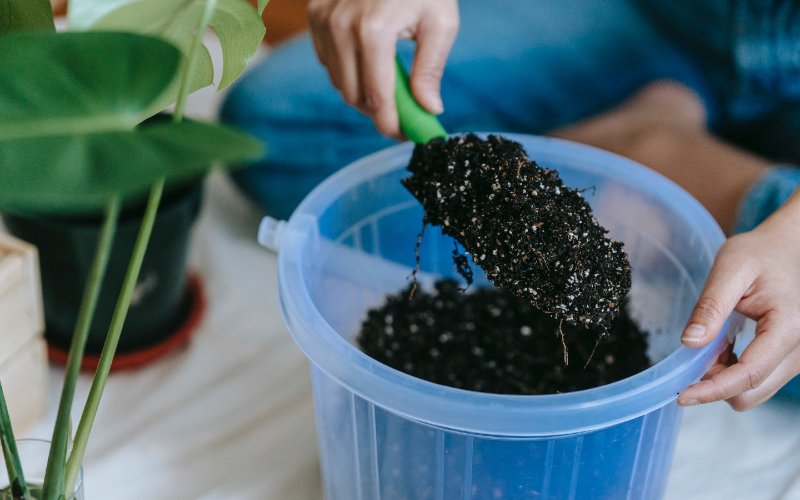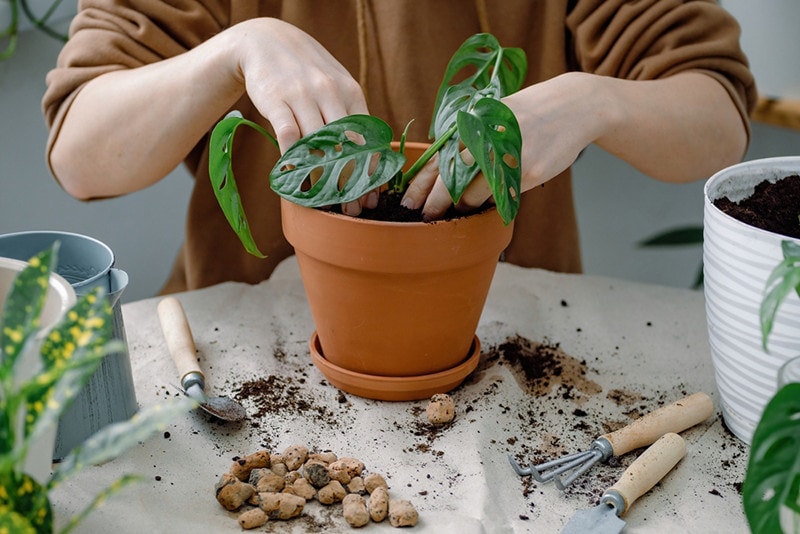How to Deal With Mold in Potting Soil – 5 Expert Tips
-
Ashley Bates
- Last updated:

Mold can be problematic for some houseplants—and people! Mold spores can be very easy to breathe in, causing a display of symptoms. So, it’s essential to know what to look for in the soil, and eradicate the problem as you go.
So, why do you get mold in plants? You guessed it—moisture. Moisture is a prime breeding ground for mold that can cause a quick spread of spores through the home.
Here are ways to cut down or eliminate mold in your potting soil entirely.
The 5 Tips to Deal With Mold in Potting Soil
1. Frequently Check for Mold

Just make it part of your routine. When you water your plants, it is important to give your soil a quick look. Not only can other problems arise, such as pests, but there can be mold growing in your plants without you knowing.
Quickly look under leaves at the soil surface to see if you can spot any growth. The quicker you can get ahead of the problem, the less impact it will have.
2. Sterilize Soil
Sometimes, it’s best to sterilize your soil to get it back to an appropriate state. Compounds like hydrogen peroxide prevent bacteria and illnesses from infiltrating your plants and eliminate other problems, like mold.
You can always consider repotting if you feel like flushing your plants completely. If you do, you can take the soil and bake or microwave it. The intense heat works to eliminate any problem that might exist in the soil.
3. Let Your Plant Get Light

Plants getting adequate sunlight will help dry out the soil and prevent mold. Since mold prefers moist environments, the sun will eliminate that on the soil surface, taking care of the problem. Of course, different plants require various levels of sunlight throughout the day.
Some plants cannot tolerate direct sunlight, so that should be taken into consideration. If it’s not in the particular plant’s best interest, skip this tip. Exposing plants that need shady environments to too much sun can be detrimental.
4. Allow the Soil to Dry Completely Between Watering
Soil that is constantly wet is a prime breeding ground for mold. Even though some plants require rather moist soil, you should allow it to dry out between watering as much as possible. Keeping the soil relatively dry will potentially discourage mold from growing therein.
Again, this only applies to plants that can withstand the soil drying out between watering. If your plant requires moisture to thrive, this step won’t be an option for that plant species.
5. Tidy Up

Make sure to keep your plants perfectly presentable. When you water them, do a double-take to make sure no dead leaves or debris need to be picked up. If you have any unnecessary gunk in the pot, it can create pathways for mold to thrive.
So, if you see a dead leaf or two, remove it as you go. Not only will this keep your plants looking aesthetically pleasing, but other problems will also decrease, too.
Dangers of Mold Exposure
If you have mold in the home, it can be pretty irritating to some people—and it’s never a good thing to get in your airways. Mold spores are very tiny particles that travel through the air. It can cause all sorts of respiratory problems, like:
- Watery eyes
- Runny nose
- Sneezing
- Breathing difficulties
- Itching
- Coughing
- Headache
- Wheezing
Mold exposure can increase your risk of infections and other illnesses. So, when it could be lurking in inconspicuous places, like in your houseplants, you could be affected for a long time before you connect the dots.
In Conclusion
If you own houseplants, you will likely deal with mold at some point. As long as you do everything you can to prevent it, you can eliminate a lot of the likelihood. However, knowing how to treat it is a valuable thing to learn.
Remember, mold loves moisture. So, keep a special close watch on your shady, rich soil-loving plants. They may be more prone to mold than drier varieties.
Featured Image Credit: Firn, Shutterstock
Contents

